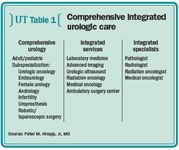Article
How large urology group practices improve care, lower costs
To meet the challenges of a changing specialty, urologists across the country have organized into large, comprehensive integrated practices, often including physicians from other specialties, to deliver the highest quality care and service to patients with urologic diseases and conditions.

This article reviews the integrated care model and its components, and explains how this model improves the quality of care while lowering health care costs.
The comprehensive integrated care model

Subspecialization

The emergence of robot-assisted laparoscopic surgery and the specialized training it requires has resulted in the concentration of radical prostatectomy and partial nephrectomy into the hands of specialty-trained urologic surgeons. Most practices report referring patients in need of robot-assisted laparoscopic surgery to the appropriate specialty-trained urologist in their group. Concentration of surgical care to high-volume operators increases the experience of the surgeon, resulting in improved quality and outcomes.
Subspecialization in areas of female urology, male infertility, surgical oncology, endourology, and stone disease also promotes internal referrals in large groups for specialty care. Diagnostic evaluation, medical and surgical treatment, and long-term maintenance therapy are streamlined and more advanced when administered by well-trained, experienced subspecialty experts.

















